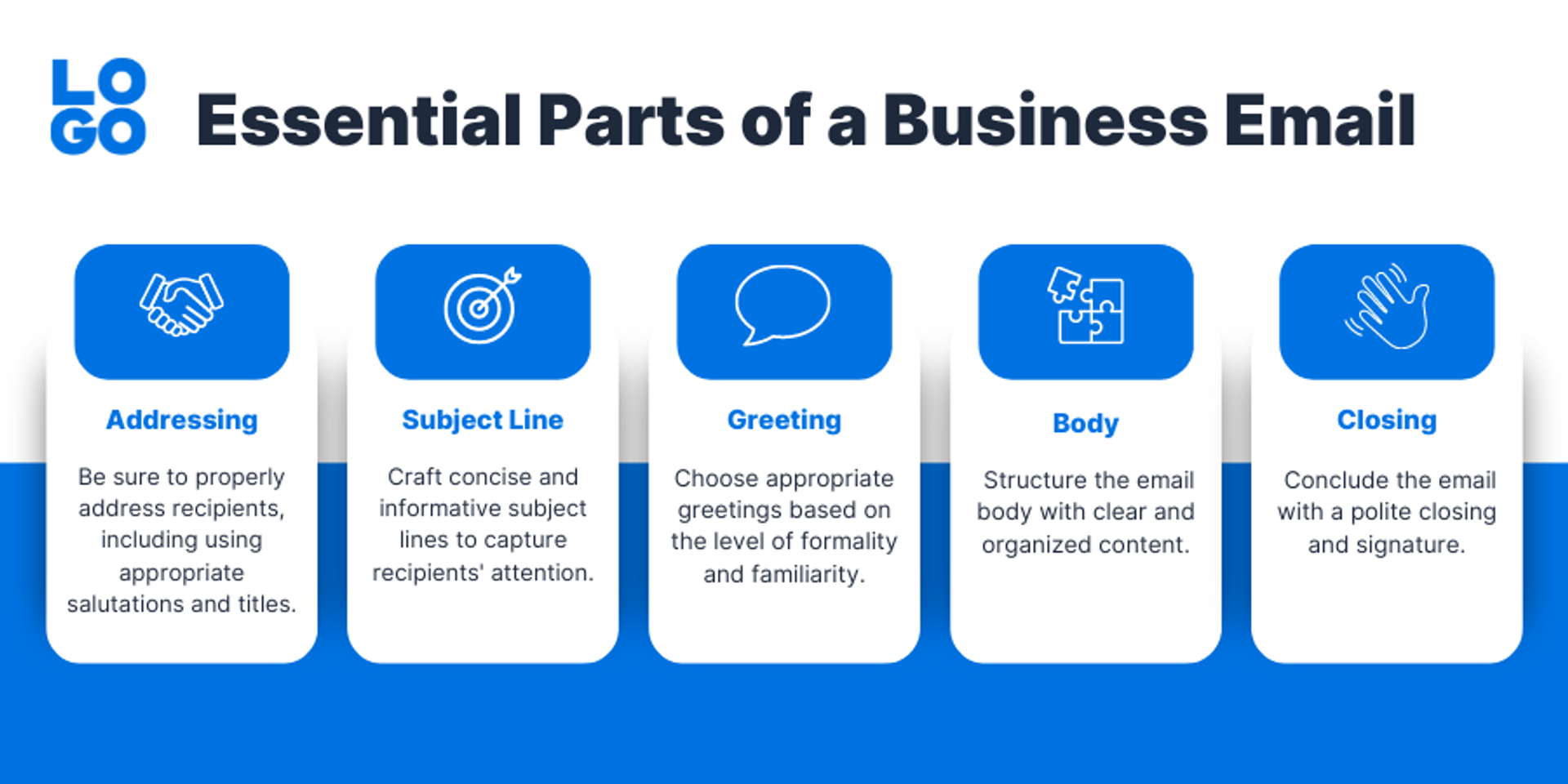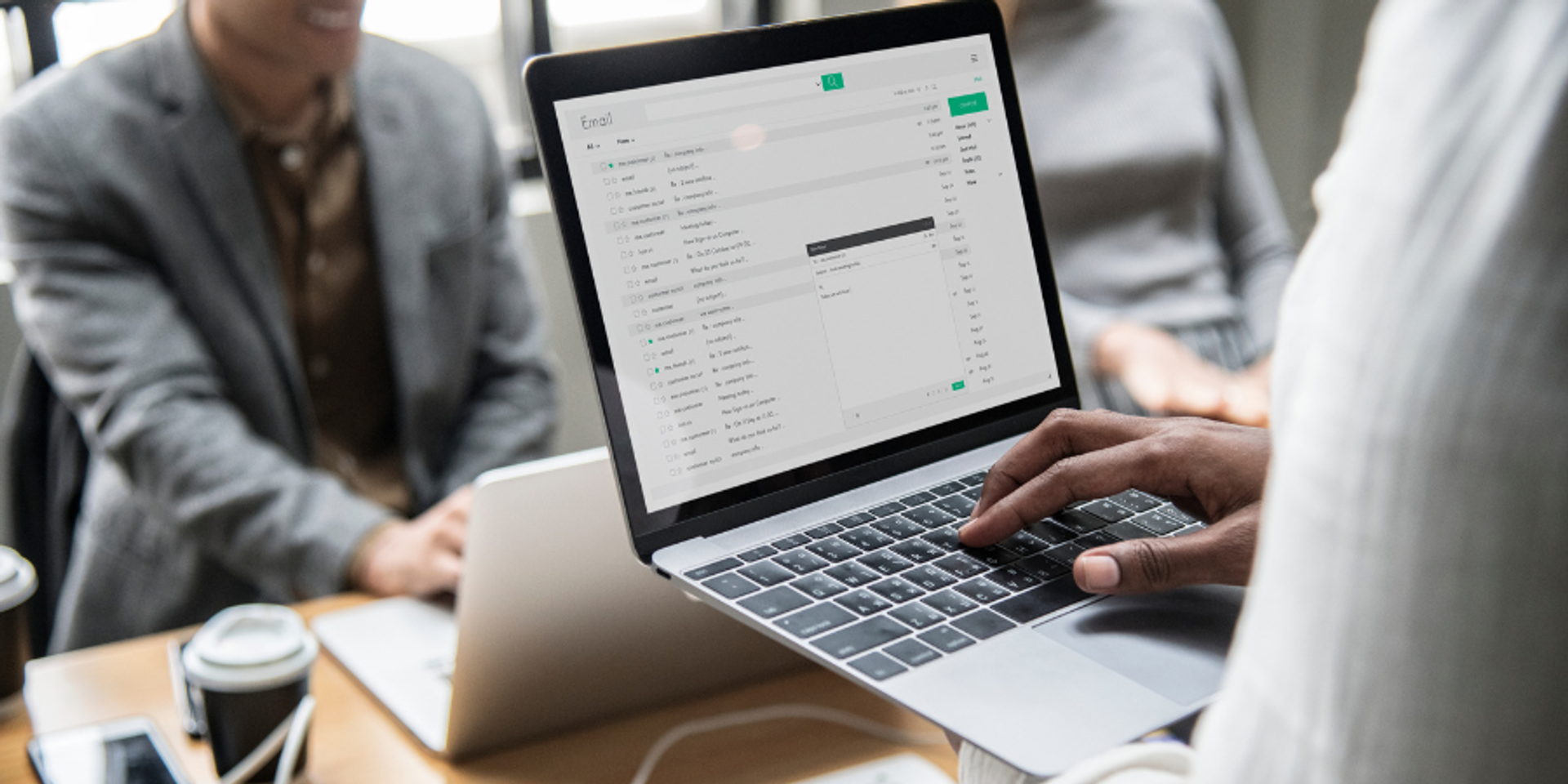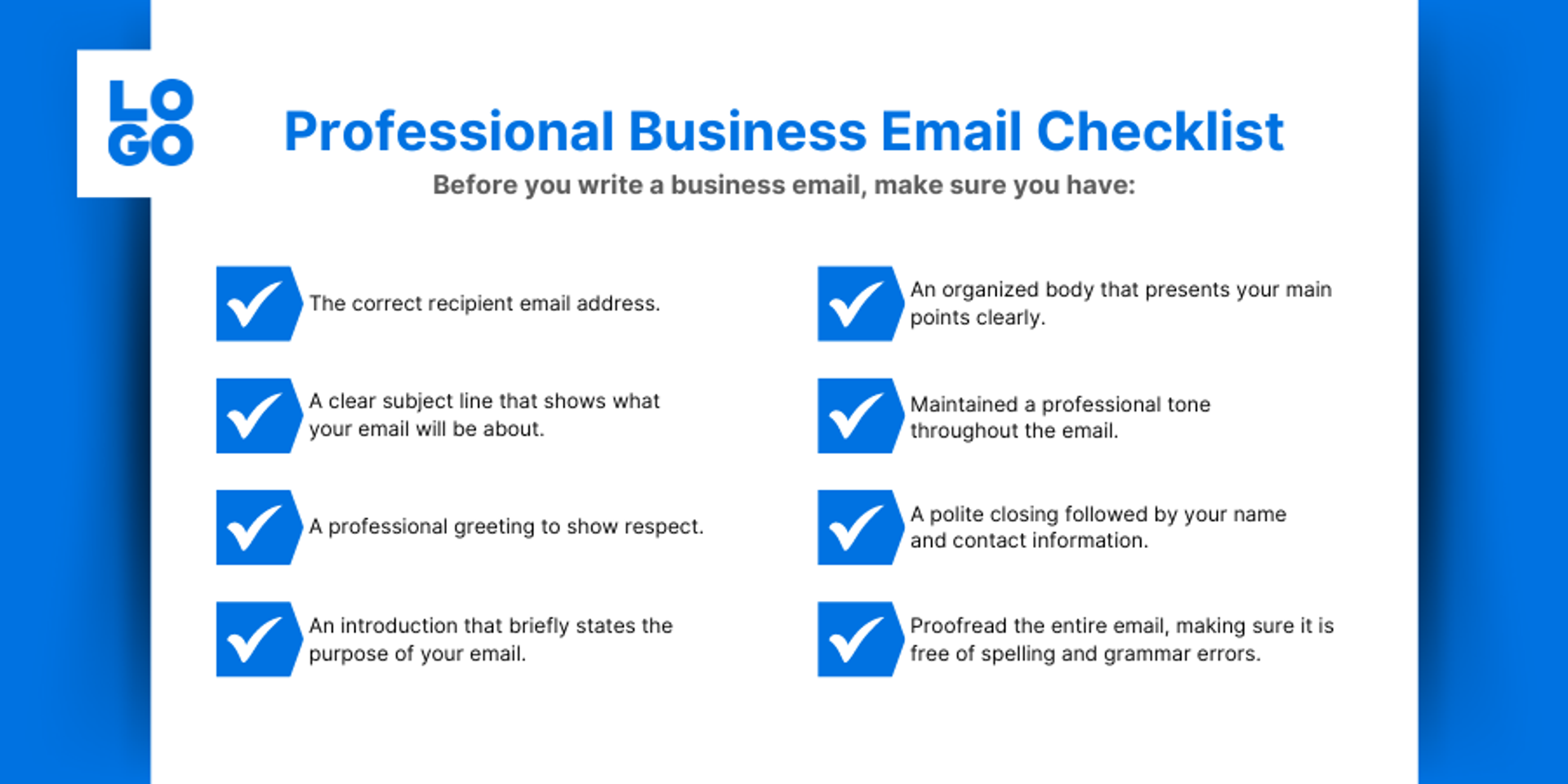How to Write a Professional Business Email
March 7, 2024
By: LOGO

Table Of Contents
As a business owner, you know that email communication is key to building strong professional relationships. No matter how small your business may be, writing emails that leave a positive and lasting impression on your recipients is crucial. Whether you're a seasoned pro or just starting out, this guide will help give you valuable insights on how to write professional business emails to your customers.
A well-crafted email is not just a message—it's a bridge to your next client, a handshake with your future partner, and the opening line of your next success story. You don't need to be a mega-corporation to send emails that make an impact. In fact, the charm of a small business is its heart and soul—qualities that can shine through in every email you send.
In this guide, we'll explore the key elements to composing emails that resonate with professionalism and personality, no matter where you are on your business journey. From the first "Hello" to the final "Looking forward to hearing from you," every sentence is an opportunity to showcase your product or services. Let's get started!
The Impact of Effective Business Emails
Crafting professional business emails is a necessity for business owners. Emails serve as a primary mode of communication, and the tone, structure, and content play a vital role in shaping customer relationships, fostering credibility, and driving success.
Ready to make your logo?
Here are two ways mastering professionalism in your business emails can elevate your business reputation:
1. First Impressions Matter
When it comes to your business, it's important to keep in mind how you're perceived by others. Writing friendly and well-crafted emails is a great way to leave a positive impression on your customers.
How you communicate through email sets the tone for your professional image, and by keeping it friendly and professional, you can improve the credibility of your message and present yourself in the best light possible. By creating friendly and professional emails, you reinforce your business’s credibility and show your customers that you're dedicated to providing excellent service.
2. Building Strong Relationships Through Clear Communication
Emails are an excellent way to showcase your professionalism and attention to detail, which can help instill confidence in the recipient. Keeping your message clear and concise while being friendly and approachable can establish trust and credibility with your customers in no time.
Being professional is crucial to earning the trust and respect of your current and potential customers. Writing friendly and engaging emails ensures that your message is conveyed clearly and that there are no chances of confusion or misinterpretation. After all, the more your customers trust you, the more likely they are to become loyal customers.
5 Parts to Include in Every Business Email

Every email you send is the beginning of a friendly chat at your local market—an opportunity to greet, inform, and make a memorable impact on your fellow small business owners.
Here’s how to craft the perfect email that feels as inviting as your shop's open sign:
Addressing: Address your recipient with the warmth and recognition you would a regular patron. Whether it's an inviting "Good morning, [Name]" or a respectful "Hello [Name]," let them feel seen right from the start.
Subject Line: Think of the subject line as your storefront – it should be inviting and clear. A dash of intrigue and a sprinkle of information will have your readers eager to open your email.
Greeting: Just as you set the ambiance in your store with a smile or a nod, begin your email with a greeting that lays out a welcome mat. It could be as simple as "I hope this message finds you well" or "It's great to connect with you again."
Body: In the body of your email, arrange your words in an organized way that’s easy to read. Start with what's most important—why you're reaching out—and guide them through your message with clear, accessible language. Remember, not everyone speaks 'business' fluently.
Closing: Be sure to end your email on a note that invites further conversation. A "Looking forward to our next chat" or a simple "Take care" can be the warm farewell that keeps the relationship growing.
By including these essential parts in your professional business emails, you’ll continue to build lasting relationships with your customers.
Tips for Writing a Professional Business Email

Crafting a well-written business email is an essential skill that can seal or break the deal. Whether you're sending a formal proposal, reaching out to a prospective client, or following up with a colleague, knowing how to compose professional emails is crucial. With the right tone, structure, and language, you can create an impactful message that leaves a positive impression on the reader.
Here are the essential tips and guidelines for writing a professional business email to effectively communicate your message and achieve your goals.
Knowing When to Hit "Send"
As a small business owner, you wear many hats, and knowing when to send off a professional email is crucial. Whether it's pitching your services to potential clients, following up after a productive meeting, or addressing customer inquiries promptly, the timing of your emails can significantly impact their effectiveness. Reaching out to potential clients at the right moment can make the difference between sealing a deal and getting lost in the shuffle.
Pro Tip: The right time to send an email depends on your customers, the purpose of the email, and your business. However, many people check their inboxes first thing in the morning, so sending emails during early morning hours will help prevent your email from getting overlooked.
Choose the Right Subject Line
When it comes to emailing, having the right subject line is important as it's the first thing your recipients will see. It's essential to make it clear and engaging to capture their attention and give them an idea of what the email is all about. You can increase open email rates by writing an attention-grabbing subject line, ultimately leading to more sales.
Here are a few more reasons why subject lines are important in your professional business emails:
- A well-written email subject line can grab the attention of the recipient.
- The subject line sets the expectations of the email and gives the recipient an idea of what the email will be about.
- Well-crafted email subject lines can help ensure the email is delivered to the recipient’s inbox, not their spam folder.
- A catchy email subject line can encourage the recipient to open and read the email.
If you’re thinking of sending “cold-open emails” (sending an email to someone you don’t know), make sure your subject lines spark a little curiosity. After all, your goal is to get new and existing customers to do business with you. If your email subject line is a little uninteresting, it might end up in the trash folder.
Check out these statistics on how important subject lines are:
- 69% of email recipients will report emails as spam if the subject line is not impressive.
- 33% of email recipients will open your email if it has a catchy subject line.
Pro Tip: Avoid using vague or generic subject lines. Instead, be specific and clear. For example, use a line like "Unlock Savings: Limited-Time Deals Await from [Your Business Name]."
Personalize Your Greeting
If you want to make the recipient of your email feel appreciated and valued, start by greeting them with a personalized message. Using their name and the appropriate salutations based on your relationship can go a long way in setting the right tone.
For instance, if you are reaching out to potential clients or business associates, it is best to begin with "Dear" for a formal feel. However, if you are communicating with colleagues or existing clients, you can use "Hi" or "Hello" for a more casual tone.
6 Ways to Start Emails
- Hi [Name] - This is best for most circumstances and is one of the most popular ways to greet people through email because it’s friendly, direct, and personal.
- Hello [Name] - This is a little more formal than beginning with “Hi” and is just as popular. It may be more suitable for official business professionals' cold-open emails.
- Dear [Name] - This is the best for formal emails and for contacting a person in a position of respect or authority.
- Greetings - This is a safe and polite way to start an email and can be used for emailing one person or multiple people at once.
- Hi there - This is mostly used as an email greeting for individuals and large groups
- To Whom it May Concern - This is best to use when the recipient's name is unknown.
Be Clear and Concise in Your Message
If you want to write an effective business email, it's important to keep it clear, concise, and straight to the point. Use short sentences and make your main message clear from the beginning.
Don't worry about sounding too technical or using fancy words that might confuse the person you're emailing. Instead, try to organize your information using bullet points or numbered lists to make everything easy to understand. That way, you can be sure you're getting your point across in the most friendly and effective way possible.
Tailor the Tone to the Recipient
When it comes to sending emails, it's important to be mindful of the recipient and tailor your tone accordingly. One helpful approach is to think about their position, relationship with your business, and the purpose of your message. If you're reaching out to potential clients, partners, or executives, a more formal tone is generally advisable. This might involve using proper titles and using a professional salutation and closing.
If you're sending an email to people you're familiar with or your colleagues, then it's okay to adopt a friendly and informal tone. This could mean using a laid-back greeting and ending and perhaps even injecting some humor into your message. But, regardless of the recipient, it's crucial to maintain a polite, clear, and concise communication style.
Include a Call-to-Action
A well-crafted CTA helps you achieve your intended purpose and shows respect for the recipient's time by providing clear direction. Be specific about what you need from them, whether it's scheduling a meeting, providing feedback, or taking a particular action.
Keep the tone friendly and approachable, and make sure your CTA is straightforward, concise, and easily understandable. Whether you want to schedule a meeting, ask for a review, get feedback, or ask for any other specific action, including a clear CTA, it helps you get the best response from your recipient.
Polite Closing and Signature
When you're writing a business email, it's always a good idea to end it with a friendly closing remark and your professional signature. This way, your recipient knows who they're communicating with and how they can contact you if they need to. You can use phrases like "Best regards," "Sincerely," or "Thank you" to show your appreciation.
Once you're done with the closing, don't forget to include your full name, job title, contact information, and any relevant social media or website links for further contact or reference. By doing so, you can make sure that your email recipients have all the information they need to get in touch with you or learn more about your work. This might seem like a small detail, but it can go a long way in making a positive impression and building strong professional relationships.
Personalize Professional Email Signatures
Have you ever thought about creating an email signature?
A good business email signature is all about being simple, informative, and prominently showcasing key details about yourself and your business. But this doesn't mean your email signature must be bland or uninspiring.
With LOGO.com's email signature maker, you have access to a variety of sleek templates that seamlessly incorporate your logo, business name, and other key information that you can simply copy and paste into your email signature settings.
Proofreading Your Email Before Hitting “Send”
Picture this: You've crafted a stellar email to your customers, showcasing your latest product or service. You hit send in a rush, eager to share your excitement. But wait! A tiny typo sneaks in, changing 'complementary' to 'complimentary.'
Suddenly, your professional image takes a hit, and your message loses its impact. That's why it’s essential that you proofread before you send out emails – it's not just about catching typos, it's about ensuring your message resonates loud and clear with your audience.
Pro Tip: Take advantage of free resources like Grammarly and Quilbot that you can use to help you improve your writing. Grammarly focuses on grammar and spelling while boosting your writing quality overall, and Quilbot specializes in paraphrasing, synonym suggestions, and translating languages.
7 Steps to Writing an Email Like a Pro

Ready to make your logo?
When composing a professional business email, it's important to keep in mind the following key aspects:
1. Clear and Concise Subject Line: The subject line is the first thing the recipient sees, so make sure it clearly conveys the purpose of your email.
2. Professional Greeting: Start your email with a formal greeting that addresses the recipient respectfully, such as "Dear [Recipient's Name]."
3. Introduction: Begin your email with a brief introduction, stating your purpose and providing context for the message.
4. Body of the Email: Present your main points clearly and logically, using paragraphs to separate different ideas or topics.
5. Professional Tone: Maintain a formal and professional tone throughout the email, avoiding slang or casual language.
6. Polite Closing: End your email with a courteous closing, such as "Sincerely" or "Best regards," followed by your name and contact information.
7. Proofreading: Always proofread your email for spelling and grammar errors before sending it to ensure clarity and professionalism.
Professional Business Email Examples
Two of the most essential emails you will send as a small business owner will be those that show our appreciation and ones that are reminders or follow-ups.
Below, you'll find templates for both types of emails that feel genuine and are perfect for continuing to grow your relationships with your customers. Whether you're saying “thank you”, or reaching out with a gentle reminder, these templates are designed to show your customers and clients just how much you value their business.
Thank You for Your Business
Imagine your customer just made a purchase, and you have the chance to leave a lasting impression that goes beyond the transaction. This is where the "thank you for your business" email comes in. It's a warm smile and a nod of gratitude that can turn a one-time customer into a loyal fan.
Helpful Template to Use
Subject: Thank You for Trusting Us with Your [Project/Service]
Hi [Customer's Name],
I hope this message finds you well. I just wanted to say thank you for choosing [Your Business Name] for your recent [project/service].
We're so happy to hear that you're pleased with how the [project/service] turned out. Your support means everything to us, and we're grateful for the opportunity to help you. At [Your Business Name], our goal is to provide you with the best possible service and exceed your expectations, and we're glad we could do that for you.
Your feedback is extremely important to us as we continue to grow and improve. If you have any thoughts or comments about your experience with us, please don't hesitate to share them. We're always here to listen and make sure you're completely happy.
Thank you again for choosing us for your [project/service]. We hope to have the chance to work with you again in the future.
With gratitude,
[Your Name]
[Your Position/Title]
[Your Contact Information]
[Your Business Name]
Follow-Up Emails
Perhaps you've recently met with a potential client or a customer who expressed interest in a service but hasn't taken the next step. A well-crafted follow-up can be the subtle breeze that nudges the sailboat forward on the customer's journey.
Helpful Template to Use
Subject: Follow-Up: Our Conversation on [Specific Topic]
Hi [Recipient's Name],
I hope this email finds you well. I wanted to follow up on our recent conversation regarding [specific topic or discussion point]. It was a pleasure speaking with you, and I appreciated your insights.
Since our discussion, I've had time to reflect on our potential collaboration and am even more excited about the possibilities. I believe there's great potential for [mention potential benefits or outcomes of collaboration].
I wanted to check in and see if you have further thoughts or questions about moving forward. If you need any more information or if there's anything that's been bothering you, feel free to let me know.
Would you be available for a follow-up call or meeting to discuss next steps in more detail? Please let me know your availability, and I'll make sure to accommodate you.
I am looking forward to reconnecting and continuing our conversation.
Best regards,
[Your Name]
[Your Position/Title]
[Your Contact Information]
[Your Business Name]
Writing Perfect and Professional Emails Everytime
Writing professional business emails is an important skill that can boost your business communications. To make sure your emails are well-written and well-received, following our tips means you will get the most out of your professional business emails. Leave a positive impression on your recipients, and you will build stronger relationships to help your business grow and prosper in the long run!



